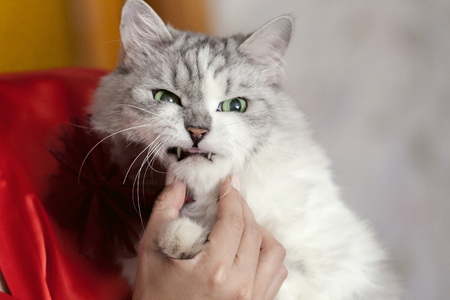Introduction: What Is Cat Purring?
When you think of cats in American homes, chances are the gentle, rhythmic sound of purring comes to mind. Whether your cat is curled up on the couch or brushing against your leg in the kitchen, purring is a common—and often comforting—part of daily life for millions of cat owners across the U.S. But what exactly is cat purring, and why does it capture our attention so much?
The Basics of Cat Purring
Purring is a low, continuous, vibrating sound that cats produce, usually when they are relaxed or content. However, this familiar noise can also pop up in unexpected moments—like during visits to the vet or after a stressful situation—leaving many people to wonder what’s really behind this mysterious feline behavior.
Common Situations When Cats Purr
| Situation | Possible Reason for Purring |
|---|---|
| Lounging on your lap | Contentment and bonding |
| During petting sessions | Enjoyment and relaxation |
| At the vet’s office | Self-soothing during stress |
| Near mealtime | Anticipation or communication |
| While recovering from injury | Pain relief and healing support |
Purring in American Households: More Than Just a Cute Sound?
For many Americans, a purring cat is a sign that their furry friend is happy and healthy. But because cats also purr in unusual circumstances—sometimes when they’re scared or unwell—the real science behind why cats purr is both fascinating and a bit puzzling. Understanding this behavior isn’t just about decoding our pets’ moods; it might even provide clues about their health and well-being.
2. How Do Cats Physically Produce Purrs?
Ever wondered how your cat’s soothing purr is actually made? It’s not just a cute quirk—it’s a fascinating process that involves both the body and the brain working together. Let’s break down exactly how it happens.
The Role of the Brain
Everything starts in your cat’s brain. When a cat feels content, safe, or even in need of comfort, the brain sends a signal down to the voice box—also known as the larynx. Think of it as flipping a switch that tells the body, “It’s time to purr!”
How the Signal Travels
| Step | What Happens? |
|---|---|
| 1. Feeling Triggered | Your cat feels happy or calm. |
| 2. Brain Sends Signal | A message travels from the brain to the voice box. |
| 3. Muscles Get Moving | Laryngeal muscles start twitching rapidly. |
The Magic of the Vocal Cords
When those signals reach the larynx, something cool happens: special muscles inside your cat’s throat start to twitch really fast—20 to 30 times every second! This rapid movement causes the vocal cords to separate and come together, producing that familiar humming sound we call purring.
Inside the Larynx: What’s Going On?
- Laryngeal Muscles: These tiny muscles open and close the space between the vocal cords.
- Air Flow: As your cat breathes in and out, air vibrates across the vocal cords.
- Purr Sound: The vibration creates those rhythmic sounds you know and love.
Purring: Inhale and Exhale
Cats are unique because they can purr continuously while breathing both in and out. That means you hear a steady, uninterrupted rumble, unlike most animal sounds that only happen on an exhale.
A Quick Comparison
| Animal | Purrs While Breathing In? | Purrs While Breathing Out? |
|---|---|---|
| Cat | Yes | Yes |
| Dog (rare) | No | Sporadically |
| Tiger (big cats) | No (roar instead) | No (roar instead) |
This special ability makes your kitty’s purr one-of-a-kind! Next time you hear that gentle rumble, you’ll know there’s some amazing science at work underneath all that fluff.
![]()
3. Why Do Cats Purr? Instincts, Comfort, and Communication
When you hear your cat purring, it’s natural to wonder what’s really going on inside their furry little head. Is it happiness, a sign of good health, or something more? The truth is, purring is a complex behavior rooted in cat instincts, comfort-seeking habits, and even the way they communicate with both other cats and humans.
Kittenhood Bonding: Purring Starts Early
Cats begin purring when they’re just a few days old. For kittens, purring is like an “I’m okay” message to their mother while nursing. It helps moms keep track of their babies—especially since kittens are born blind and deaf. This early purring builds a strong connection between mom and kitten, laying the foundation for future communication.
Purring as Self-Soothing: Comfort and Healing
Many people notice that cats will purr when they’re curled up in a sunbeam or snuggled on your lap. But did you know cats also purr when they’re stressed or in pain? Experts believe that purring can actually help cats calm themselves down and may even promote healing. The vibrations from purring are thought to help reduce pain, decrease inflammation, and boost recovery from injury.
| Situation | Why Cats Purr |
|---|---|
| Nursing with Mom | Bonding and signaling safety |
| Cuddling with Humans | Expressing comfort and affection |
| Feeling Anxious or Unwell | Self-soothing and possible healing |
| Seeking Food or Attention | Communicating needs to humans |
Purring as Communication: Talking to Their Human Families
Purring isn’t just about feeling cozy—it’s also a social tool. Adult cats often purr to interact with us. Maybe your cat jumps on your lap and starts purring as soon as you sit down, or perhaps they weave around your feet at mealtime with a special “solicitation” purr. This unique sound blends a regular purr with a cry-like meow, making it almost impossible for humans to ignore!
Understanding Your Cat’s Purrs
The next time your cat starts up their motor, think about what might be happening around them. Are they relaxed? Hungry? Trying to get your attention? Each situation can add a different layer of meaning to their purr—and knowing this can help you build an even stronger bond with your feline friend.
4. The Link Between Purring and Cat Health
What Does Science Say About Purring?
If you’ve ever relaxed with a purring cat on your lap, you probably felt like everything was right in the world. But does purring really mean your cat is happy and healthy? Scientists have been curious about this question for years. Let’s break down what research has found—and why purring isn’t always as simple as it sounds.
Why Do Cats Purr?
Cats usually purr when they’re content—like when they’re being petted, napping in a sunny spot, or greeting their favorite person. But cats can also purr when they’re nervous, frightened, or even hurt. That means purring isn’t just a “happy sound.” Instead, it’s more like a multi-purpose tool for communication and maybe even self-healing.
When Cats Purr: A Quick Guide
| Situation | What It Might Mean |
|---|---|
| Being cuddled or stroked | Feeling safe and content |
| At the vet or when injured | Self-soothing or seeking help |
| Nursing kittens | Bonding and reassuring kittens |
| Alone and resting | Relaxation or self-healing |
Purring and Physical Health: Is There a Connection?
Some scientists believe that the vibrations from purring (usually between 25 and 150 Hertz) may actually help cats heal. Studies suggest these frequencies can promote healing of bones and tissues, reduce pain, and even decrease swelling. That might be why cats often purr when they’re recovering from injuries.
The Healing Power of Purring?
- Bone Healing: Certain frequencies of purring may stimulate bone growth and repair.
- Pain Relief: The act of purring may release endorphins, helping cats feel less pain.
- Stress Reduction: Purring can calm not only cats but also people who listen to them!
Is Purring Always a Good Sign?
This is where things get interesting. While a purring cat is often a happy one, there are exceptions. Some sick or stressed cats will still purr—even when they need medical help. For example, a cat with an injury might purr to comfort itself or signal distress to humans. So while purring is usually positive, it’s important to look at the big picture—like your cat’s appetite, energy level, and behavior—to truly know how your pet is feeling.
5. When Purring Might Signal a Problem
Purring is usually thought of as a sign that your cat is happy and comfortable, but sometimes it can mean something else entirely. For American pet parents, its important to pay attention to the context and other warning signs that might go along with your cats purrs. Sometimes, cats will actually purr when they’re in pain, stressed out, or even feeling sick.
Why Would a Cat Purr When Stressed or in Pain?
Cats have evolved to use purring as a way to self-soothe and communicate with humans and other animals. In the wild, injured cats may purr to calm themselves or signal that they are not a threat. At home, your cat might purr when visiting the vet or after an injury — not because theyre happy, but because theyre trying to cope with discomfort.
Warning Signs for Pet Parents in the U.S.
If you notice any of these behaviors along with purring, it could be time to check in with your veterinarian:
| Warning Sign | What It Might Mean | When to Worry |
|---|---|---|
| Hiding more than usual | Stress, fear, or illness | If hiding lasts for more than a day or two |
| Lack of appetite | Pain, dental issues, digestive problems | If your cat refuses food for over 24 hours |
| Limping or trouble jumping | Injury or arthritis | If mobility issues persist or worsen |
| Heavy breathing while purring | Respiratory distress or pain | If breathing is labored or noisy |
| Lethargy or unusual sleepiness | Illness or pain | If your cat seems weak or unresponsive |
| Purring during handling of sore spots | Coping mechanism for pain | If your cat reacts to touch by tensing up, hissing, or swatting |
| Sudden changes in behavior or mood | Anxiety, illness, stress | If new behaviors last for more than a couple of days |
Purring Isn’t Always “Good Vibes Only”
American cat owners should remember: just because your kitty is purring doesn’t always mean they’re content. Context is everything. If their body language looks off—tail tucked, ears flat, dilated pupils—or if you see any of the warning signs above along with their purrs, trust your instincts and contact your vet.
6. Purring and Its Surprising Benefits—for Cats and Humans
When your cat curls up on your lap and starts purring, you probably feel a little calmer—and that’s not just in your head. Scientists have been curious about the calming sound of a cat’s purr for years, and what they’ve found is pretty amazing. Purring isn’t just a cute habit; it offers real benefits, not only for cats but for us humans, too.
How Does Cat Purring Affect Cats?
Cats purr at a frequency between 25 and 150 Hertz (Hz). According to research, these vibrations may help cats heal themselves. Here’s how:
| Benefit for Cats | Description |
|---|---|
| Pain Relief | Purring releases endorphins that can act as natural painkillers. |
| Bone Healing | The vibration frequencies are believed to promote bone strength and healing. |
| Stress Reduction | Purring helps lower stress levels after a scary or painful experience. |
| Wound Healing | The gentle vibrations may support tissue repair and decrease swelling. |
Purring Isn’t Just Good for Cats—It Helps People, Too!
If you’ve ever felt your own stress melt away when petting a purring cat, you’re not alone. Studies suggest that being around a purring cat can actually have health benefits for people:
| Benefit for Humans | Description |
|---|---|
| Lower Stress & Anxiety | The soothing sound and vibrations from purring can help calm nerves and reduce anxiety. |
| Improved Heart Health | Cat owners may have lower risk of heart attacks—possibly due to the relaxing effects of purring. |
| Better Sleep | The rhythmic sound can make it easier to relax and fall asleep. |
| Mood Boosting | Interacting with a purring cat can release “feel-good” chemicals in your brain. |
The Science Behind the Soothing Sound
Researchers believe the repetitive, low-frequency vibrations of a cat’s purr trigger our body’s relaxation response. This means lowered blood pressure, slower breathing, and an overall sense of calm—just by sharing space with your furry friend. It’s no wonder so many Americans call their cats “emotional support animals” even if they aren’t officially registered as such!
7. Conclusion: Interpreting Your Cat’s Purrs at Home
Understanding your cat’s purring goes beyond enjoying their soothing sounds—it’s about tuning into what your feline friend is really trying to tell you. In American households, where cats are cherished members of the family, recognizing the nuances behind a purr can help you respond with confidence and care.
Every Cat Is Unique
Just like people, every cat has its own personality and habits. Some cats purr often, while others are more reserved. Here’s a quick guide to help you match common purring patterns with possible meanings:
| Purring Situation | What It Might Mean | How to Respond |
|---|---|---|
| Cuddling in Your Lap | Contentment, trust | Keep petting or softly talking—your cat feels safe! |
| At Mealtime | Excitement or anticipation | Stick to regular feeding times for security |
| Purring When Alone | Self-soothing | Check for signs of stress or boredom; offer toys or playtime |
| Purring With Unusual Behavior (hiding, limping) | Pain or discomfort | Observe closely—if symptoms persist, contact your vet |
| Purring During Vet Visits | Nervousness or self-comforting | Stay calm and speak gently; bring a familiar blanket or toy for reassurance |
Practical Tips for American Cat Owners
- Observe Patterns: Take note of when and how your cat purrs. Are they kneading your lap? Are their ears back? Context matters.
- Create Comfort: Cats thrive on routine and familiar spaces. A cozy bed in a quiet spot can encourage happy purring.
- Health First: Sudden changes in purring—especially if paired with hiding, loss of appetite, or aggression—should be checked by a vet.
- Bond Through Interaction: Try gentle brushing or interactive toys. Responding to your cat’s contented purrs builds trust and strengthens your bond.
- Respect Their Space: Not all cats want constant attention. If your kitty walks away mid-purr, give them space—they’ll come back when they’re ready.
Your Cat’s Purr: More Than Just a Sound
Purring is part of the rich language that makes sharing life with a cat so rewarding in American homes. By observing your pet’s cues and responding thoughtfully, you’re not just guessing—you’re building a lifelong friendship built on understanding.


